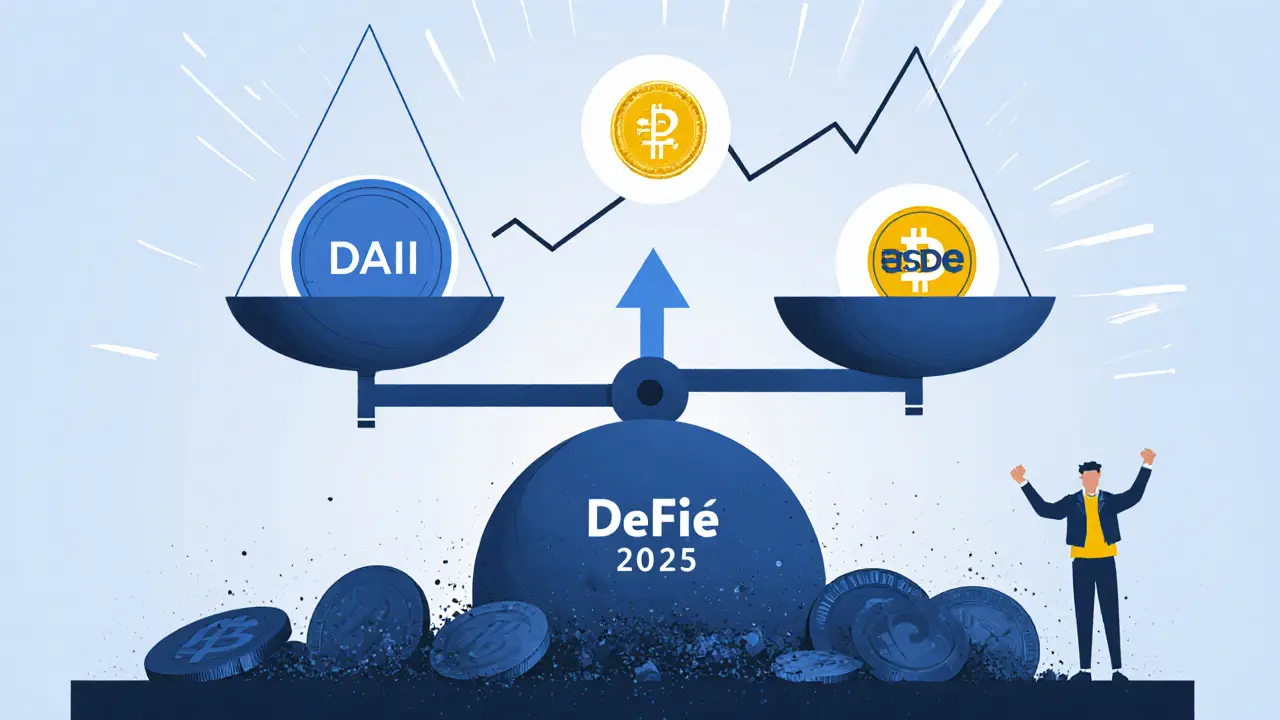Best Stablecoins for DeFi and Trading in 2025
 Oct, 31 2025
Oct, 31 2025
Stablecoin Portfolio Allocator
Allocate Your Stablecoin Portfolio
Why This Allocation?
Based on the article's recommendations, your allocation will prioritize:
- USDC for liquidity and trading
- DAI for DeFi safety
- USDe for yield (only with risk tolerance)
- FRAX as a balanced alternative
Remember: Never put all your stablecoin eggs in one basket. This allocation helps spread risk across the most reliable stablecoins.
Recommended Allocation
Liquidity, trading, stability
DeFi safety, decentralization
Yield farming (risk)
Balanced alternative
Estimated Annual Yield
0.00%
Risk Profile
Low Risk
How to Use This Allocation
When you're trading crypto or farming yield in DeFi, your stablecoin isn't just a placeholder-it's your lifeline. Pick the wrong one, and you could lose money to slippage, frozen funds, or a collapse you didn’t see coming. Pick the right one, and it becomes the engine behind your profits. In 2025, the stablecoin landscape isn't what it was five years ago. The era of pure algorithmic coins is over. The winners now are the ones that balance stability, liquidity, and yield without relying on risky magic.
USDC: The Liquidity King
If you need to move fast, USDC is your go-to. With over $30 billion in circulation, it’s the most liquid stablecoin on every major exchange-Coinbase, Binance, Kraken, you name it. Traders love it because spreads are tight, slippage is near zero, and withdrawals settle in seconds. On Curve Finance, swapping USDC for DAI or USDT costs less than 0.05% in fees and slippage, even for $100,000 trades.
But there’s a catch: USDC is centralized. Circle, the company behind it, can freeze addresses. In 2023, they froze $75 million tied to a sanctioned wallet. That’s fine if you’re trading on a regulated exchange, but if you’re using it in a DeFi protocol where you don’t control the private keys, you’re trusting a company with legal power over your assets. For short-term trading or quick exits, USDC is unbeatable. For long-term DeFi exposure, it’s a liability.
DAI: The Decentralized Workhorse
DAI is the only stablecoin that doesn’t rely on a bank or a company. It’s backed by crypto collateral-ETH, WBTC, USDC-locked in MakerDAO’s smart contracts. To mint one DAI, you need to deposit at least $1.50 worth of collateral. That overcollateralization is what keeps it stable even when ETH crashes 40% in a day.
It’s integrated into over 400 DeFi protocols, from Uniswap to Aave to Compound. If you’re lending, borrowing, or swapping on a decentralized exchange, DAI is the default. It doesn’t get frozen. No one can turn it off. And unlike USDT, it’s fully transparent-every collateral vault is on-chain and auditable.
But DAI isn’t perfect. During extreme market stress, like the March 2020 crash or the 2022 LUNA collapse, DAI briefly depegged to $0.95. It recovered within hours thanks to arbitrageurs and MakerDAO’s emergency mechanisms. If you’re holding DAI long-term, you’ll occasionally need to adjust your collateral if the value of your deposited assets drops. But for most users, that’s just a minor technicality. DAI is the only stablecoin you can truly own.
USDe: The Yield Generator
USDe, launched by Ethena in 2024, is the new kid on the block-and it’s already worth over $5 billion. Here’s how it works: instead of holding dollars, USDe is backed by Ethereum (ETH) and short futures contracts. This creates a delta-neutral position, meaning it doesn’t move with ETH’s price. The profit? Ethena earns interest from the futures market and passes it to users as yield.
As of October 2025, USDe offers between 8% and 15% APY, depending on the platform. You can stake it on Aave, deposit it into Curve pools, or lend it through Convex Finance. That’s way higher than USDC’s 4-5% on centralized platforms.
But here’s the trade-off: you’re trusting complex smart contracts. If the futures market misprices or the delta-neutral hedge fails, USDe could depeg. It’s never happened yet, but it’s a new model with untested limits. Most experts recommend using USDe only for yield farming-not as your main store of value. Keep your core capital in DAI or USDC, and park your excess in USDe for the extra return.

FRAX: The Hybrid Middle Ground
FRAX is a hybrid stablecoin. Part of it is backed by collateral (USDC), part of it is algorithmic. The system adjusts the ratio automatically based on demand. If FRAX trades above $1, the protocol mints more. If it drops below $1, it burns FRAX to reduce supply.
After the Terra collapse, FRAX scaled back its algorithmic component. Today, it’s about 85% collateralized, making it much safer than it was in 2022. It still offers around 5-7% APY on platforms like Frax Finance and Curve, and it’s accepted on many DeFi apps.
FRAX is ideal if you want something more decentralized than USDC but don’t want the complexity of DAI’s collateral management. It’s not as widely adopted as DAI or USDC, but it’s growing fast. If you’re looking for a stablecoin that’s not fully centralized but still low-risk, FRAX is worth a look.
USDT: The Legacy Contender
Tether (USDT) still holds the largest market cap among stablecoins, with over $110 billion in circulation. It’s the most traded stablecoin on Binance and other non-KYC exchanges. If you’re trading on a platform that doesn’t support USDC, USDT is your only option.
But Tether’s reserves have always been murky. They claim to hold cash and equivalents, but they’ve never provided a full, independent audit like Circle does. In 2021, they paid an $18.5 million fine for misleading investors. Since then, they’ve improved transparency, but trust is still an issue.
For trading on centralized exchanges, USDT is fine. For DeFi, avoid it unless you have no other choice. DAI and USDC are safer and more transparent. USDT is the dinosaur of stablecoins-still around, still used, but not the smartest choice for the future.
Which One Should You Use?
Here’s how to pick based on what you’re doing:
- For trading on centralized exchanges: Use USDC. Fast, liquid, and regulated.
- For DeFi lending, borrowing, or swapping: Use DAI. It’s decentralized, trusted, and widely accepted.
- For earning yield: Use USDe. It’s the highest-paying option, but only allocate what you can afford to lose.
- For a balanced middle ground: Use FRAX. Decentralized enough, stable enough, and pays decent yield.
- Avoid: Pure algorithmic stablecoins like the old UST. And don’t rely on USDT for anything beyond quick trades on Binance.
Smart users don’t put all their stablecoin eggs in one basket. A common strategy is to hold 50% in DAI for DeFi safety, 30% in USDC for trading liquidity, and 20% in USDe for yield. That way, you’re covered across all use cases without overexposing yourself to any single risk.
What’s Changing in 2025?
MakerDAO is transitioning from its old system to Sky, a new governance model that makes DAI even more resilient. Ethena is integrating USDe into more protocols, including major Layer 2s like Arbitrum and Optimism. Curve Finance is expanding its stablecoin pools to 15 blockchains, reducing cross-chain friction.
Regulations are catching up too. MiCA in Europe now requires stablecoin issuers to hold liquid reserves and publish monthly reports. That’s why USDC is booming in Europe. The U.S. is working on its own stablecoin bill, expected in 2026. That could push USDT and USDC even further ahead-and make DAI’s decentralized model even more valuable.
The bottom line: stablecoins are no longer just about staying at $1. They’re about earning yield, staying decentralized, and moving fast. The best ones in 2025 aren’t the biggest-they’re the smartest.
Is USDC really safe for DeFi?
USDC is the most liquid stablecoin in DeFi, but it’s not fully safe. Circle can freeze addresses, and if regulators demand it, your funds could be locked. Use USDC for trading or short-term positions, but avoid locking large amounts in protocols where you don’t control your keys. For true DeFi safety, DAI is the better choice.
Can USDe depeg like TerraUSD did?
USDe is not algorithmic like UST. It’s backed by ETH and futures contracts in a delta-neutral setup. That means it doesn’t rely on market confidence alone-it’s mathematically hedged. UST collapsed because it was a pure algorithmic system with no real collateral. USDe has over $5 billion in backing. It’s still risky because it’s new, but the mechanism is fundamentally different.
Should I mint my own DAI?
Only if you’re comfortable with collateral management. Minting DAI requires depositing crypto worth 150% of the DAI you want. If your collateral’s value drops too much, your position gets liquidated. For most users, buying DAI directly on Uniswap or Coinbase is simpler and safer. Minting is for advanced users who want to earn yield from collateral or avoid exchange fees.
Which stablecoin has the lowest fees on DeFi?
On Ethereum, DAI and USDC have similar gas costs since they’re both ERC-20 tokens. But on Layer 2s like Arbitrum or Polygon, USDC often has lower fees because it’s more widely used and optimized. For cross-chain swaps, Curve Finance’s multi-chain pools offer the cheapest routes with under 0.1% slippage and low bridge fees.
Is FRAX better than DAI for yield farming?
FRAX offers slightly higher yields than DAI-around 5-7% vs. 3-5%-but DAI is more widely accepted. If you’re farming on Curve or Aave, DAI will give you access to more pools and better liquidity. FRAX is a good secondary option if you want a bit more yield without going full synthetic like USDe. But don’t expect FRAX to replace DAI as the DeFi standard.
What’s the best way to switch between stablecoins?
Use Curve Finance for swaps between DAI, USDC, USDT, and FRAX. It’s designed for stablecoins and has the lowest slippage. For cross-chain swaps (like moving from Ethereum to Arbitrum), use Symbiosis Finance-it’s fast, cheap, and transparent. Avoid using centralized exchanges unless you’re doing large trades and need instant settlement.
Will USDT disappear in 2026?
No, but its role will shrink. With MiCA and upcoming U.S. regulations, only compliant stablecoins like USDC and soon-to-be-regulated USDT will survive in mainstream finance. USDT will still be used on non-KYC exchanges and in countries with capital controls, but its dominance in DeFi and institutional use will fade. DAI and USDC are the future.
Next Steps
If you’re new to stablecoins, start simple: buy USDC on Coinbase and swap a small amount to DAI on Uniswap. Try using both in a lending protocol like Aave to see how they behave. Once you’re comfortable, add 10% of your portfolio to USDe for yield. Don’t chase high APYs without understanding the risk. Stablecoins are the foundation of DeFi-build on solid ground.